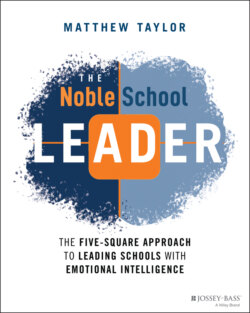Читать книгу The Noble School Leader - Matthew Taylor - Страница 23
School Leadership Is Primarily Emotional Work …
ОглавлениеIn our focus on educational outcomes, we often lose sight of the fact that learning and teaching are fundamentally emotional work. People need to feel emotionally safe to learn. There have been multiple studies showing that emotional connection is a condition for learning:
A concept from graduate school that has stayed with me is Vygotsky's Zone of Proximal Development theory. The idea here is that, for people to learn new skills, a trusted “knowledgeable other” must guide and encourage them as a first step (Penguin Dictionary of Psychology 2009).9
Research on memory has made it very clear that what makes its way into long‐term memory is almost always associated with a strong emotion (Bloom 1956).10
Bloom's Taxonomy identifies the affective domain—marked by feeling tone, emotional acceptance, or rejection—as one of three domains for learning. The affective domain is the gateway to learning. If the emotional gates aren't open, learning can't get in. Research on memory makes sense when considering the affective domain. What makes its way into long‐term memory is almost always associated with a strong emotion (Conway, Anderson, and Larsen 1994).11
Goleman writes that how the brain’s reaction to emotional stimuli shows that negative emotions shut down cognitive function while positive ones both reinforce existing synapse connections and create new neural pathways (Karen 1998).12
Attachment research shows that connection and trust is a prerequisite to learning for people who have experienced trauma, and that this connection does not come easily (Boyatzis in Coursera).13
Meeting a human being's needs for connection is a prerequisite to their being able to learn from their teacher. Once a teacher has met their student's need for connection, the work of learning can begin. The second core ingredient then comes into play: challenge. The education sector is much more fluent in the challenge component of learning. Academic rigor is the focus du jour, and as a sector we are making headway on the “what” of academic skills. However, effective challenge in teaching and learning is both a “what” and a “how” endeavor. Effective challenge stimulates intrinsic motivation and energizes a learner to strive to meet their full potential. This is a largely human, emotional endeavor that is inextricably linked to the connection between teacher and student.
This book is grounded in the belief that a school leader's job is to create the conditions for the people in their schools to reach their full potential. The two conditions leaders must create for each individual are connection and challenge. These conditions are emotional conditions. They are necessary for both students and teachers alike because emotions are contagious. If the connection and challenge needs of teachers are not being met, then the teachers will not be able to create the right conditions for students.
